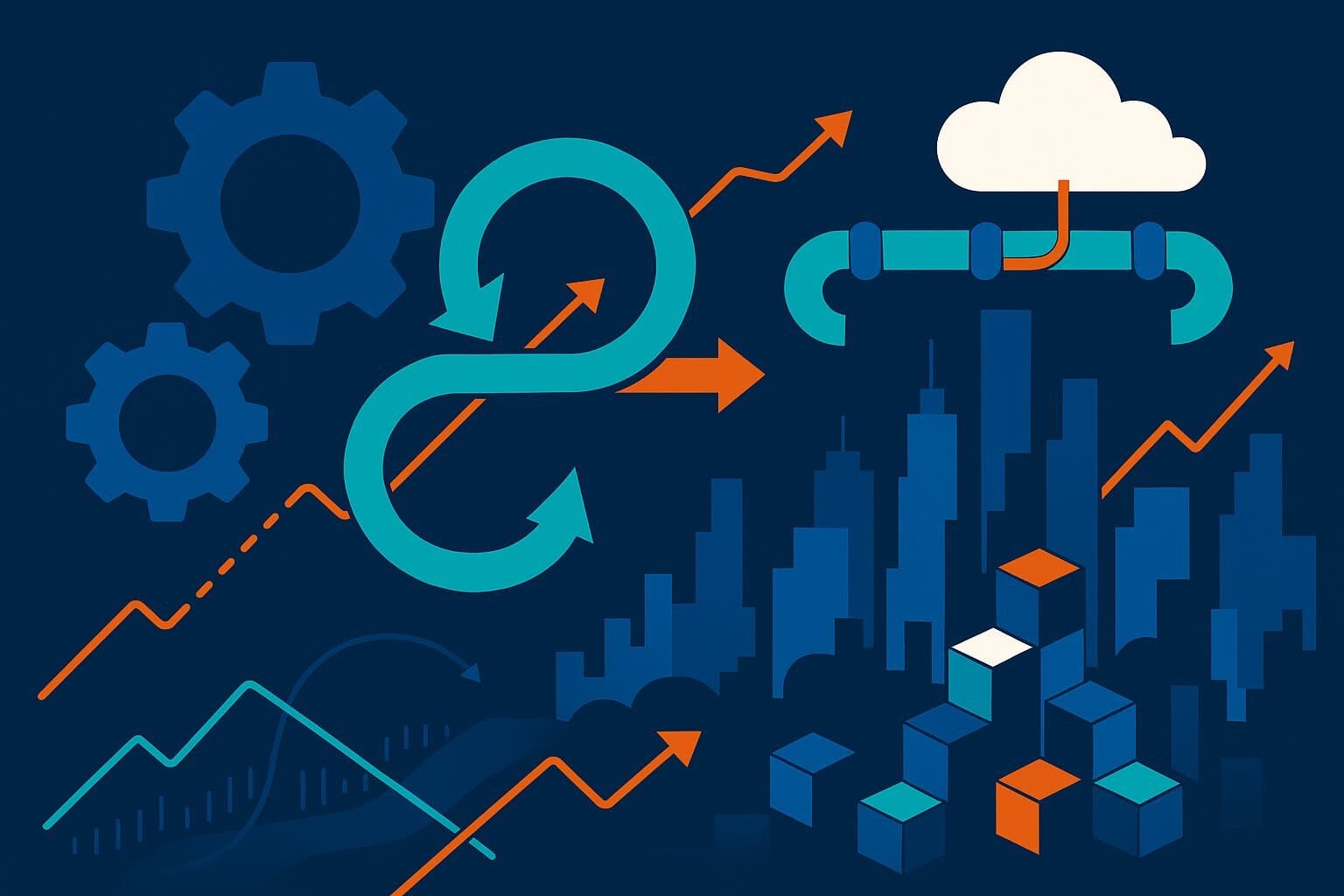
Software Development Jargon Explained: An Executive’s Guide to Agile, DevOps, CI/CD & Microservices
September 19, 2025 / Bryan ReynoldsDecoding the Jargon: A Business Leader's Glossary to Software Development
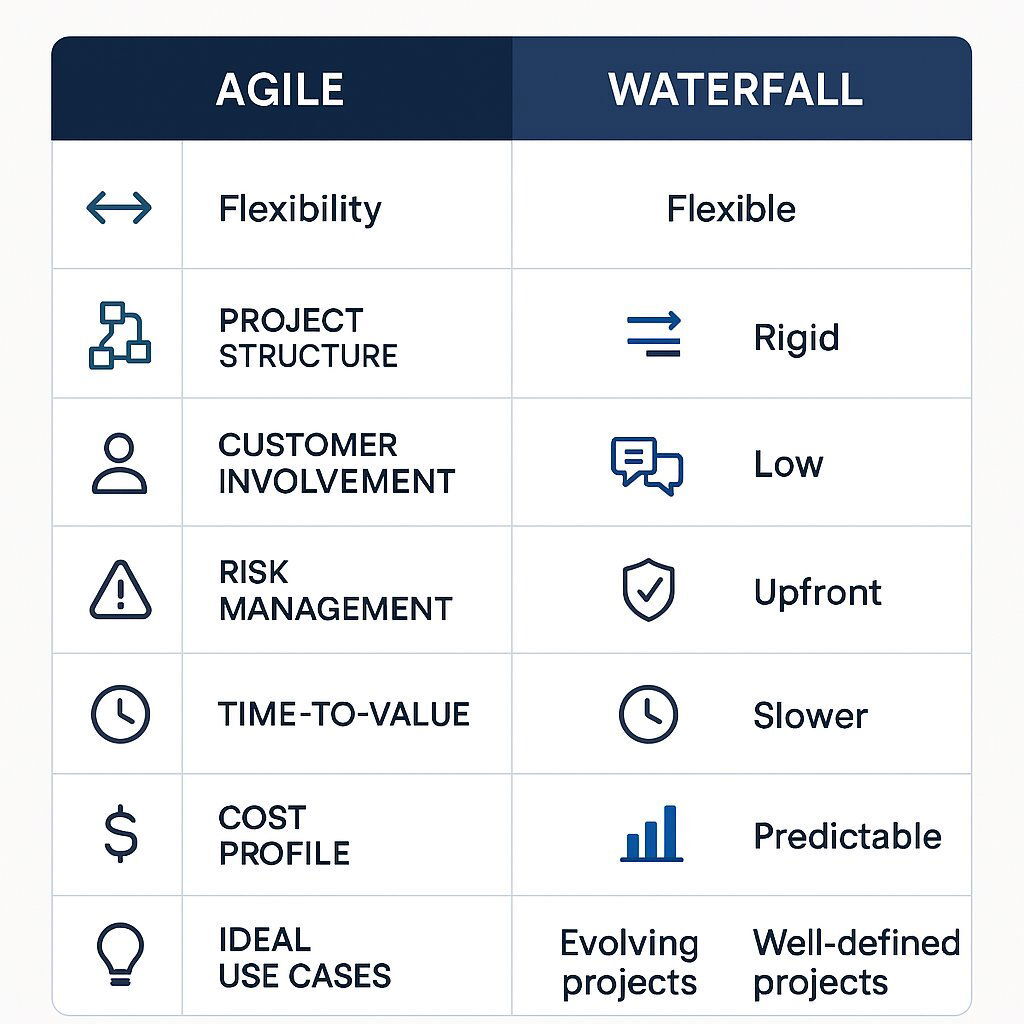
You're in a strategy meeting, and the conversation is a blur of 'sprints,' 'pipelines,' and 'microservices.' You know these terms are important, but you're focused on the P&L, not the command line. What do they actually mean for the business? And why should you, a strategic leader, care?
This is a common and completely valid position for executives in today’s tech-driven landscape. The language of software development can feel like an impenetrable barrier, yet the concepts it describes are the very engines of modern business growth.
Consider this your strategic briefing, not a technical manual. We're here to provide comprehensive, honest answers to the real questions business leaders have about the technology that powers their growth. Together, we will translate these critical concepts into the language of business outcomes: faster time-to-market, reduced costs, higher customer satisfaction, and a stronger, more resilient competitive edge.
Part 1: The Blueprint — How Your Software Gets Built (Methodologies)
Before a single line of code is written, a foundational decision must be made: how will we build this? The answer lies in choosing a software development methodology. This isn't just a project manager's preference; it's a strategic choice that dictates a project's flexibility, speed, and ability to react to the market. The two dominant philosophies are Waterfall and Agile.
The Foundational Choice: Waterfall vs. Agile
The Waterfall Model: Building Like a Skyscraper
The Waterfall model is the traditional, linear approach to software development. Think of it like constructing a skyscraper. First, you need a complete, signed-off architectural blueprint (Requirements). Only then can you lay the foundation (Design). You can't put up the walls (Implementation) before the foundation is set, and you certainly can't have tenants move in (Verification/Testing) until the structure is complete.
Each phase must be 100% finished before the next one begins, with progress flowing downwards like a waterfall—there's no going back up. This method prizes predictability, comprehensive documentation, and a clear, upfront understanding of the final product. It works best in environments where requirements are fixed and the end goal is perfectly clear from the start.
The Agile Model: Sculpting a Masterpiece
Agile is an iterative and flexible approach born directly out of the perceived shortcomings of Waterfall's rigidity. The analogy here is of a sculptor who begins with a block of marble and a clear vision for the masterpiece within. Instead of following a rigid, step-by-step plan, the sculptor works in focused bursts, chipping away at the stone, stepping back to assess the form, gathering feedback, and then refining the work.
In software terms, these focused bursts are called "sprints"—short, time-boxed periods (typically one to four weeks) where a cross-functional team works to build a small, functional piece of the product. At the end of each sprint, the team delivers a working increment of the software. This approach prioritizes working software, continuous customer collaboration, and responding to change over following a rigid plan.
At a Glance: Agile vs. Waterfall for the C-Suite
For a busy executive, the differences between these two approaches have significant strategic implications. The following table provides a clear, at-a-glance comparison across the dimensions that matter most to the business.
| Characteristic | Agile Approach | Waterfall Approach |
|---|---|---|
| Flexibility & Change | Embraces change. Requirements can evolve from sprint to sprint based on feedback and market shifts. | Resists change. Changes after the initial planning phase are difficult, costly, and disruptive to the timeline. |
| Project Structure | Iterative cycles ("sprints"). The project is broken into small, manageable, and functional increments. | Linear and sequential phases. The entire project is planned upfront, and each phase must be completed before the next begins. |
| Customer Involvement | Continuous and frequent. Stakeholders provide feedback at the end of every sprint, ensuring alignment. | Limited to the start (requirements) and end (delivery). Little to no customer input during development. |
| Risk Management | Early and continuous. Risks and bugs are identified in each sprint, when they are small and easy to fix. | Late-stage discovery. Major issues may not be found until the final testing phase, making them expensive and difficult to resolve. |
| Time-to-Value | Rapid. A Minimum Viable Product (MVP) can be released quickly, allowing the business to start learning and earning sooner. | Delayed. No value is delivered until the entire project is complete, which can take months or years. |
| Cost Profile | Lower long-term cost. By building incrementally and getting feedback, teams avoid wasting money on features nobody wants. | Predictable upfront cost. However, the cost of late-stage changes or building the wrong product can be astronomically high. |
| Ideal Use Case | Dynamic projects with evolving requirements, such as launching a new product in an uncertain market. | Projects with fixed, well-understood requirements and a stable environment, like a regulatory compliance update. |
The choice between Agile and Waterfall is more than a project management decision; it's a reflection of a company's core assumptions about its market. A business operating in a volatile, uncertain industry like high-tech, gaming, or finance cannot afford to lock in requirements for a year-long project. The market will have shifted dramatically by the time the product is delivered. In such an environment, choosing Waterfall isn't just a methodological error; it's a strategic misalignment that presumes a level of certainty that simply doesn't exist. Opting for Agile signals an organizational commitment to customer-centricity and the adaptability required to thrive in a dynamic landscape.
Why You Should Care: The Bottom-Line Impact of Agility
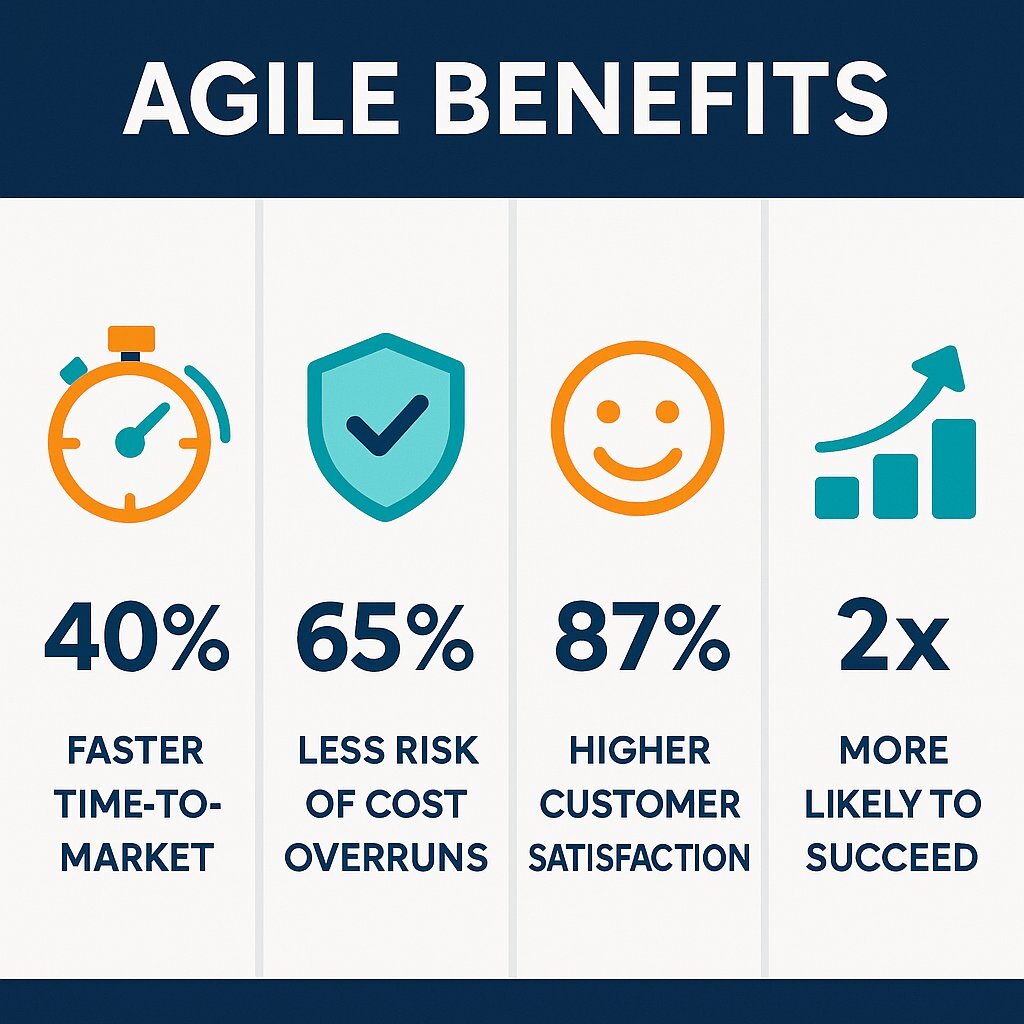
The preference for Agile in modern business isn't just a trend; it's a data-driven strategic shift with a direct, measurable impact on performance.
The data doesn't lie. Companies that adopt Agile methodologies report stunning improvements across key business metrics. Studies show they achieve a 40% faster time-to-market , allowing them to seize opportunities and respond to competitive threats more quickly. This speed doesn't come at the expense of the budget; in fact, Agile leads to a
35% reduction in development costs by minimizing wasted work and focusing resources on features that deliver real value.
Perhaps most importantly, the continuous feedback loop inherent in Agile leads to 87% higher customer satisfaction rates . By involving customers throughout the process, the final product is far more likely to meet their actual needs. This translates to higher adoption, better retention, and a stronger brand. Furthermore, Agile projects are significantly more likely to succeed, with some reports indicating a success rate double that of projects using traditional methods.
Chart 1: The Agile Advantage in Numbers
- 40% Faster Time-to-Market: Get revenue-generating products into customer hands sooner.
- 65% Less Risk of Cost Overruns: Avoid budget-breaking surprises by catching issues early and often.
- 87% Higher Customer Satisfaction: Build what customers actually want through continuous collaboration.
- 2x More Likely to Succeed: Increase the probability of a successful project outcome and a positive ROI.
This is why at Baytech Consulting, our approach is grounded in what we call Rapid Agile Deployment. It’s not just about building software fast; it’s about building the right software adaptively and transparently, ensuring the final product doesn't just meet an initial specification but drives the intended business outcome in a constantly changing market.
Part 2: The Engine — How Your Teams Work Together (DevOps)
If Agile provides the blueprint for what to build and when, DevOps provides the cultural and operational engine for how teams work together to deliver it at speed.
What is DevOps? (It's a Culture, Not Just a Tool)
At its core, DevOps is a cultural philosophy and a set of practices designed to break down the historical barriers between software development (Dev) teams and IT operations (Ops) teams.
To understand its impact, consider this analogy: In a traditional organization, the Dev team is like the kitchen staff at a fine-dining restaurant. Their job is to create an innovative, delicious dish (the software). The Ops team is the front-of-house staff—the servers and managers. Their job is to ensure the dish gets to the customer's table perfectly presented, at the right temperature, and that the dining experience is flawless (reliability and stability).
Historically, these two teams worked in separate "silos." The kitchen would push a dish out and blame the servers if the customer complained it was cold. The servers would blame the kitchen for taking too long. DevOps effectively puts the chef and the head server on the same team, giving them shared responsibility for the entire customer experience, from the moment the order is placed to the final, satisfied bite. This fosters collaboration, communication, and shared ownership of the business outcome.
Why You Should Care: DevOps as a Velocity and Innovation Multiplier
This cultural shift from silos to shared ownership has profound business implications. It creates an organization that can deliver higher-quality value to customers faster and more reliably than its competitors.
The business impact is tangible and transformative. DevOps accelerates software delivery, improves service reliability, enhances security by integrating it into the process (a practice known as DevSecOps), and, critically, frees up your most expensive engineering talent from manual "fire-fighting" to focus on innovation and building the next great product.
Consider a real-world example from the B2B SaaS industry. A fast-growing company found itself trapped by its own success. Deployments were a high-risk, all-hands-on-deck event that happened only once a month. Their highly paid senior engineers were spending nearly a third of their time (30%) on this "operational drag"—managing fragile infrastructure and manually pushing updates. By implementing a DevOps culture and automating their release processes, the results were dramatic. They moved from monthly to daily deployments, cut their cloud infrastructure costs by 40% through better efficiency, and reduced the time engineers spent on manual operations to less than 5%. This unlocked thousands of hours of top-tier talent, redirecting it from just "keeping the lights on" to building new, revenue-generating features.
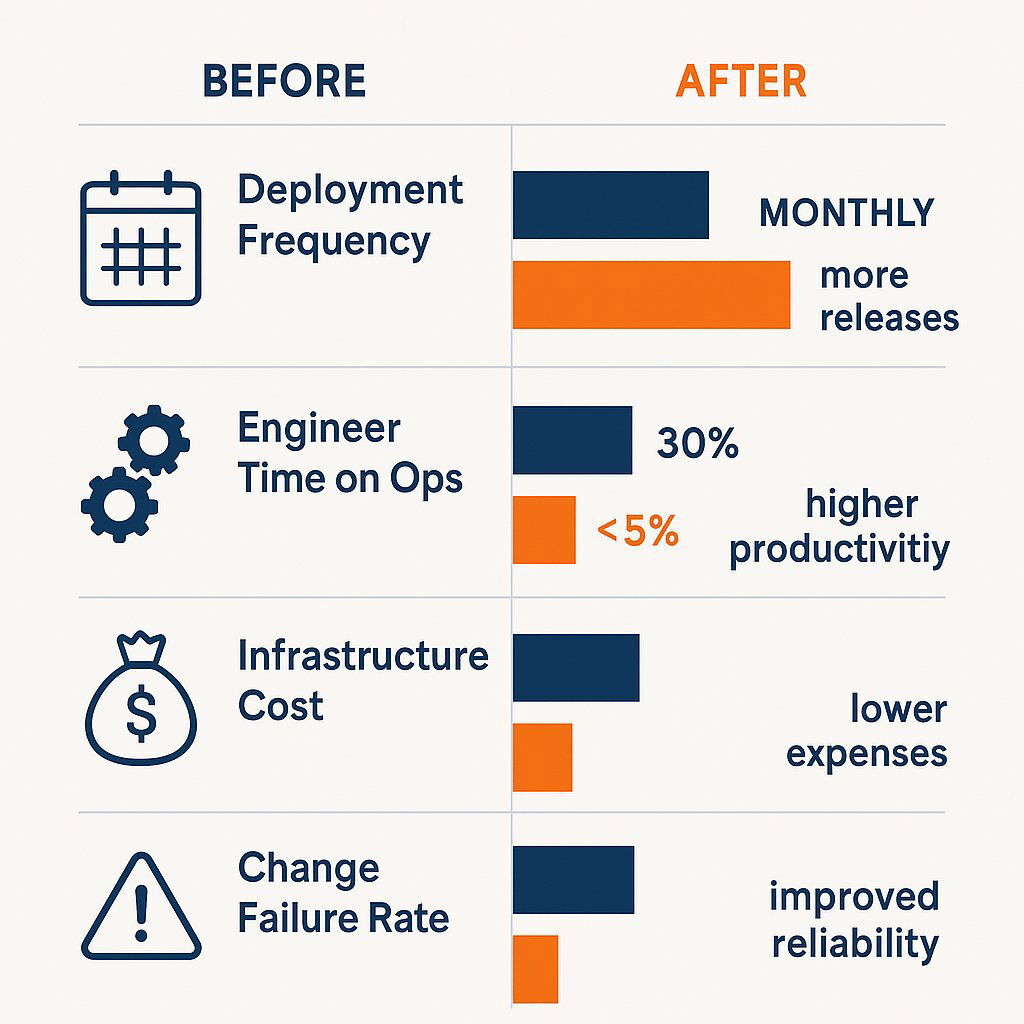
Chart 2: The DevOps Transformation: Before and After
| Metric | Before DevOps | After DevOps | Business Impact |
|---|---|---|---|
| Deployment Frequency | 1 per month | Daily | Massively accelerated time-to-market |
| Engineer Time on Ops | 30% | <5% | Freed senior talent for innovation |
| Infrastructure Costs | £25,000/month | £15,000/month | Increased gross margin and profitability |
| Change Failure Rate | 15% | <1% | Dramatically increased system stability |
| (Data based on a B2B SaaS case study ) |
Ultimately, business leaders should view DevOps not as an "IT thing," but as the operational model for a modern digital business. Its core principles of maximizing flow, creating fast feedback loops, and enabling continuous learning are directly applicable to non-tech departments. A marketing team can adopt DevOps thinking to shorten the cycle between campaign launch and performance analysis. A sales team can use it to create tighter feedback loops between customer calls and product development priorities. Adopting DevOps in your technology organization can serve as a powerful blueprint for creating a more agile, responsive, and data-driven enterprise as a whole.
Part 3: The Assembly Line — How Your Product Gets to Market (CI/CD)
If DevOps is the cultural philosophy of collaboration and speed, then Continuous Integration and Continuous Delivery/Deployment (CI/CD) is the automated, high-powered assembly line that makes it a reality.
What is CI/CD? Automating the Path from Code to Customer
Think of building and releasing software like manufacturing a car.
Continuous Integration (CI) is the first part of the modern assembly line. In the old way of building cars, different teams would build the engine, chassis, and body separately and only try to bolt them all together at the very end—a process that often revealed that the parts didn't fit. With CI, every time a developer finishes a small piece of code (a new component for the car), it is immediately merged into the main codebase (the car's chassis). At this point, a series of automated robots (automated tests) instantly check to ensure the new part fits perfectly and hasn't inadvertently broken any other part of the car. This happens dozens or even hundreds of times a day.
Continuous Delivery and Continuous Deployment (CD) represent the end of the assembly line. The fully assembled, quality-checked car is now ready to be shipped to the customer. This is where a small but critical distinction comes in:
- With Continuous Delivery , the finished car is automatically moved to the loading dock, perfectly packaged and ready to go. However, it waits for a human manager to press the final "ship" button before it's loaded onto a truck and sent to the dealership. The release is a business decision.
- With Continuous Deployment , the process is fully automated. The moment the car passes its final automated inspection, it automatically drives itself off the assembly line and onto a transport truck, with no human intervention required. Every validated change goes directly to customers.
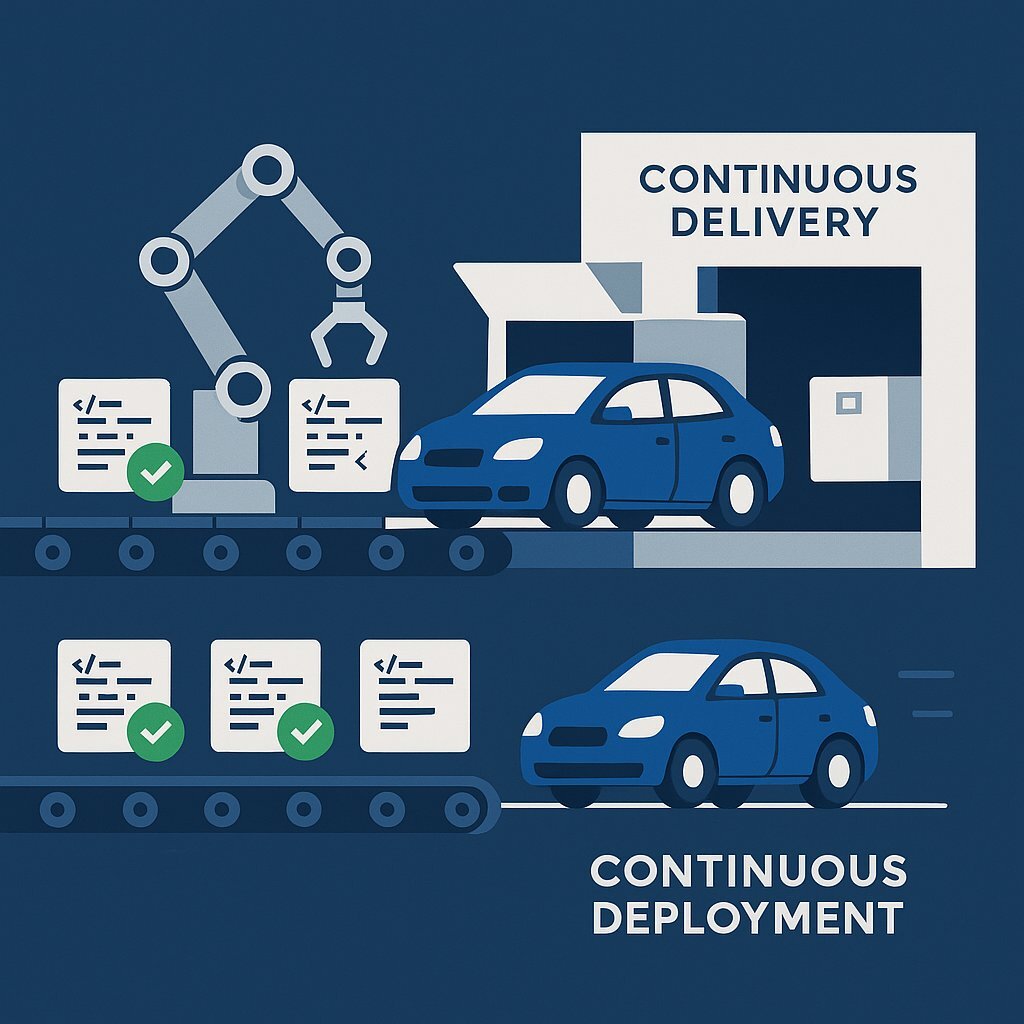
CI/CD visualized as an automated assembly line delivering quality software efficiently.
Why You Should Care: Speed, Safety, and a Shorter Feedback Loop
Automating the release process with a CI/CD pipeline delivers direct and powerful business value.
- Reduced Risk & Higher Quality: Automation dramatically reduces the risk of human error, a leading cause of production outages and costly bugs. By running thousands of automated tests on every small change, issues are caught immediately when they are cheapest and easiest to fix. This results in fewer defects reaching your customers, which means a more stable product and a better brand reputation.
- Accelerated Time-to-Value: CI/CD is the technical engine that enables the "daily deployments" discussed in the DevOps section. It allows your business to get new features, bug fixes, and security patches into the hands of customers in hours or minutes, not weeks or months. This means you start generating revenue, gathering crucial user feedback, and responding to market changes faster than your competitors.
- Increased Developer Productivity: A CI/CD pipeline automates the most tedious, repetitive, and soul-crushing parts of a developer's job. This frees up your most valuable and expensive talent to focus on what they do best: solving complex problems and creating innovative solutions that drive business value. This not only boosts productivity but also improves morale and reduces burnout.
The implementation of CI/CD fundamentally changes the economic calculation of releasing software. It transforms what was once a high-cost, high-risk, infrequent event into a low-cost, low-risk, everyday activity. When the marginal cost of a release approaches zero, it encourages a culture of experimentation. Teams can afford to test new ideas in the market quickly and safely. If an idea fails, it can be rolled back just as quickly with minimal cost or disruption. This investment in a CI/CD pipeline is a direct investment in operational efficiency, risk reduction, and, ultimately, the speed of innovation for the entire business.
Part 4: The Architecture — How Your Application is Structured (Microservices)
The final piece of the puzzle is the software architecture—the underlying structure of the application itself. Just as the design of a building determines its ability to withstand an earthquake or add a new wing, the architecture of your software determines its ability to scale, remain resilient, and evolve with your business.
What are Microservices? Building with LEGOs vs. a Block of Marble
For decades, software was typically built as a monolith . Imagine your entire application—user login, product search, payment processing, inventory management—as a single, massive sculpture carved from one block of marble. It's a single, tightly-coupled, unified piece. While elegant in its simplicity, this approach has major drawbacks. To change one small part, like altering the nose on the sculpture, you risk cracking the entire block. To handle more visitors, you have to commission an entirely new, identical sculpture. And the entire, massive piece must be moved and displayed as one unit.
A microservices architecture takes a completely different approach. It's like building that same sculpture out of thousands of individual LEGO bricks. Each core business function—user authentication, payment processing, product search—is its own small, independent service, a self-contained LEGO creation. These services communicate with each other through well-defined connection points (known as APIs), but they are built, updated, deployed, and scaled independently of one another.
Why You Should Care: Designing for Scale, Resilience, and Future Growth
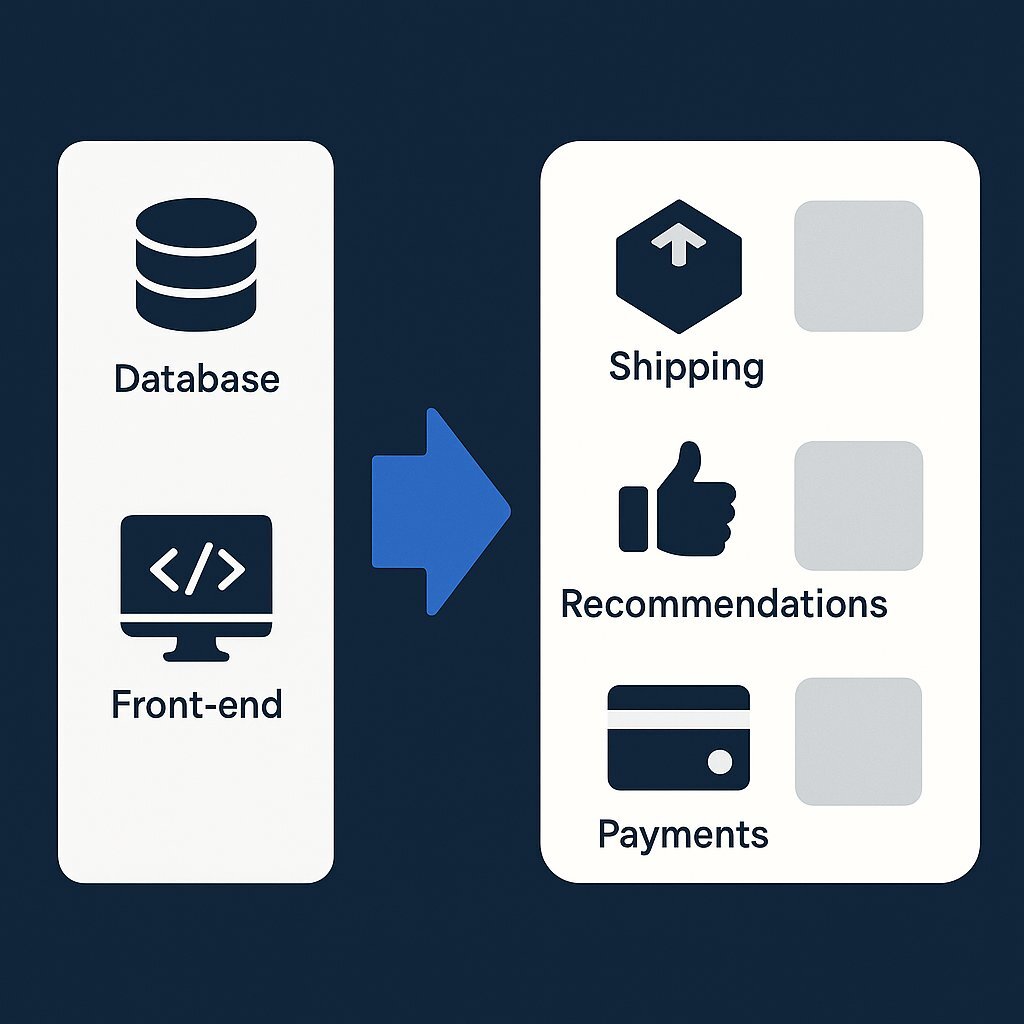
This architectural choice is not merely a technical detail; it is a long-term strategic decision that directly impacts your business's ability to grow and adapt. When it comes to developing for scale, cloud-native architecture is fundamentally important. For a deeper dive, check out our executive blueprint to cloud-native business agility to see how your organization can get future-ready.
- Targeted Scalability & Cost Efficiency: Imagine it's Black Friday and your e-commerce site's payment processing service is under immense load. With a monolithic application, you would have to scale the entire application —the product search, the user profiles, everything—just to handle the payment traffic. This is like buying ten new delivery trucks when all you needed was one extra cashier. It's incredibly inefficient and expensive. With microservices, you can scale only the payment service , adding resources precisely where they are needed and optimizing your cloud spending.
- Improved Resilience (Fault Isolation): In a monolith, a bug in the inventory management system could crash the entire application, bringing your whole business to a halt. In a microservices architecture, if the inventory service fails, the rest of the application—product browsing, adding to cart, user login—can remain fully operational. The failure is isolated, minimizing the impact on revenue and the customer experience.
- Increased Agility and Innovation: Because services are independent, small, dedicated teams can own them end-to-end. The "Search Team" can completely rewrite their service using the latest AI technology without having to coordinate with or wait for the "Payments Team." This allows for true technology diversity and accelerates the pace of innovation across the organization.
- Real-World Proof: The most famous example of this transition is Amazon. In the early 2000s, their website was a massive monolith that was becoming impossible to update and scale. Development delays were crippling their ability to innovate. By breaking the monolith down into a collection of small, independent services, they created the foundation for the massive scale, rapid innovation, and operational resilience that defines their global business today.
The decision to adopt a microservices architecture is deeply intertwined with a company's organizational design. This principle is often referred to as Conway's Law, which states that an organization will inevitably produce a system design that mirrors its own communication structure. To succeed with microservices, a company must be willing to shift from technology-siloed teams (the "database team," the "front-end team") to small, cross-functional, autonomous teams organized around business capabilities (the "shipping team," the "recommendations team"). This architectural choice forces clarity on what the core functions of the business are and makes the performance and cost of each function directly measurable. The technology architecture and the organizational chart must align. To see how custom architectures address real-world supply chain disruptions, read our article on how custom software solves manufacturing’s supply chain crisis.
This is the essence of our Tailored Tech Advantage at Baytech Consulting. By leveraging modern architectures built on powerful technologies like Docker and Kubernetes —which are the industry-standard tools for building, deploying, and managing these 'LEGO brick' services—we build solutions that are not just powerful today, but are also resilient, scalable, and ready for the future growth of your business. Curious about real-world Kubernetes scaling? Explore how enterprises scale Kubernetes effectively.
Conclusion: From Jargon to Strategy — Your Next Move
The vocabulary of software development is no longer just for the engineering department. These concepts are the building blocks of modern business strategy. By understanding them, you can ask better questions, make more informed decisions, and lead your organization more effectively in a digital-first world.
To recap, think of these concepts as a strategic toolkit:
- Agile is your framework for adapting to market change.
- DevOps is your culture for moving fast and collaboratively.
- CI/CD is your automated engine for safe, reliable delivery.
- Microservices is your architectural blueprint for scalable, resilient growth.
The next time you're in a strategy session, you'll be equipped to move the conversation from technical jargon to business impact. Here are a few questions you can ask your technology leaders to gauge your organization's maturity and identify opportunities for improvement:
- "How long does it take us to get a simple bug fix from a developer's desk to our customers? Is it hours, days, or weeks?" (This probes the efficiency of your CI/CD pipeline and DevOps culture — and if you’re striving for faster time-to-value, consider our B2B guide on software testing ROI).
- "If our most popular feature suddenly experienced ten times its normal traffic, how would our system handle it? Would the whole application slow down?" (This probes the scalability and resilience of your software architecture — and how microservices, containerization, and event sourcing can help).
- "When was the last time we significantly changed a project's direction based on new customer feedback, and how difficult was that process for the team?" (This probes your organization's true agility — and real-life business value from adopting practices outlined in the Agile Manifesto’s business impact guide).
Understanding these concepts is the first step. Applying them to drive real business results is the next. If you're ready to move from theory to practice, the experts at Baytech Consulting are here to help you build the custom software and implement the processes that will give your business a decisive competitive advantage. Let's start the conversation.
Further Reading
- https://www.mckinsey.com/capabilities/mckinsey-digital/our-insights/an-executives-guide-to-software-development
- Microservices by Martin Fowler
- https://www.planview.com/resources/articles/the-benefits-of-devops-how-a-devops-strategy-drives-innovation-and-efficiency/
About Baytech
At Baytech Consulting, we specialize in guiding businesses through this process, helping you build scalable, efficient, and high-performing software that evolves with your needs. Our MVP first approach helps our clients minimize upfront costs and maximize ROI. Ready to take the next step in your software development journey? Contact us today to learn how we can help you achieve your goals with a phased development approach.
About the Author

Bryan Reynolds is an accomplished technology executive with more than 25 years of experience leading innovation in the software industry. As the CEO and founder of Baytech Consulting, he has built a reputation for delivering custom software solutions that help businesses streamline operations, enhance customer experiences, and drive growth.
Bryan’s expertise spans custom software development, cloud infrastructure, artificial intelligence, and strategic business consulting, making him a trusted advisor and thought leader across a wide range of industries.


